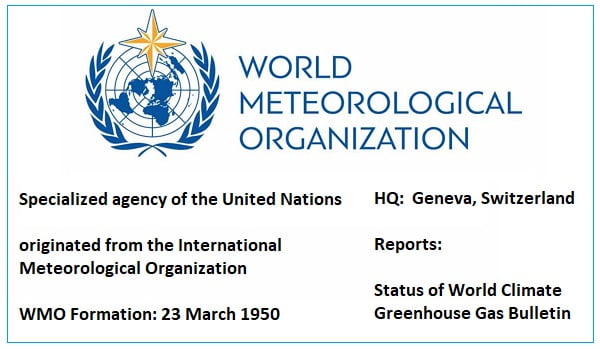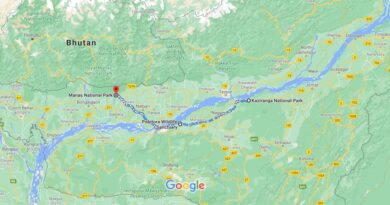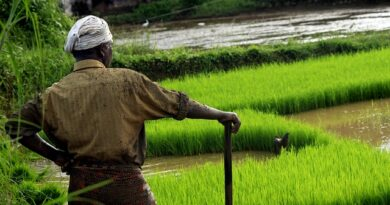WMO- World Meteorological Organization
Contents
About WMO:
- The World Meteorological Organization (WMO) is a specialized agency of the United Nations.
- It is responsible for promoting international cooperation on atmospheric science, climatology, hydrology and geophysics.
- The WMO originated from the International Meteorological Organization, a nongovernmental organization founded in 1873 as a forum for exchanging weather data and research.
- Proposals to reform the status and structure of the IMO culminated in the World Meteorological Convention of 1947, which formally established the World Meteorological Organization.
- WMO Formation: 23 March 1950, and the following year the WMO began operations as an intergovernmental organization within the UN system.
- The WMO is made up of 193 countries and territories, and facilitates the “free and unrestricted” exchange of data, information, and research between the respective meteorological and hydrological institutions of its members.
- It also collaborates with nongovernmental partners and other international organizations on matters related to environmental protection, climate change, resource management, and socioeconomic development.
- Headquartered in Geneva, Switzerland,
- India is member country
- The World Meteorological Day is held annually on 23 March.
Governance
The WMO was established by the Convention of the World Meteorological Organization, signed 11 October 1947 and ratified on 23 March 1950. The Convention serves as the constituent treaty of the WMO, setting forth its purposes, governance, and general framework.
Hierarchy:
- The World Meteorological Congress, the supreme body of the Organization, determines policy. Each member state and territory is represented by a Permanent Representative with WMO when Congress meets every four years. Congress elects the President and Vice-Presidents of the Organization and members of the Executive Council; and appoints the Secretary-General.
- The Executive Council (EC) implements Congress decisions.
- The Secretariat is an eight-department organization with a staff of 200 headed by a Secretary-General, who can serve a maximum of two four-year terms.[9]
The annually published WMO Statement on the status of the World Climate provides details of global, regional and national temperatures and extreme weather events. It also provides information on long-term climate change indicators including atmospheric concentrations of greenhouse gases, sea level rise, and sea ice extent. The year 2016 was the hottest year on record, with many weather and climate extremes, according to the most recent WMO report.[10]
As of August 2020, the WMO has a membership of 193 member states and territories
Strategic Plan
- Disaster risk reduction
- The Global Framework for Climate Services (GFCS)
- The WMO Integrated Global Observing System (WIGOS)
- Aviation meteorological services
- Polar and high mountain regions
- Capacity development
- Governance
Publications/Reports
The World Meteorological Organization publishes an annual report on the status of the World Climate. This report will provide detailed information on temperatures at the local, national and global levels along with extreme weather events.
- The WMO report also provides information on long term climate change indicators. These indicators include the rise in sea levels, the extent of sea ice and concentrations of greenhouse gases in the atmosphere.
- Other reports published by the WMO are:
- Status of World Climate
- Greenhouse Gas Bulletin (Check Both the reports and add essential data in your notes)
World Meteorological Organization (WMO) Functions
Functions of the World Meteorological Organisation can be stated as:
- Coordinating activities of National Meteorological and Hydrological Services in the member countries.
- These activities are important since they provide basic climate, weather and water services to the population in need whenever they need it.
- Providing a guarantee of publishing the statistics and observation of Meteorology and Hydrology.
- This data is further implemented in various aspects like agriculture and water management, shipping, aviation, etc.
- The WMO also encourages R&D in Meteorology and Hydrology.
- This is beneficial for reducing different weather impacts and hazards due to climate.
- This can be achieved by maintaining a consistent and reliable forecast.
- A reliable forecast is necessary for early warning systems on storms like cyclones, tornadoes, and other extreme events like flooding and droughts.
- Predicting the locust swarms and transport of various pollutants is another responsibility of the WMO.
- Pollutants like volcanic ash, toxic nuclear substances are all hazardous to human health. If their transport is detected early, various health hazards can be avoided.
WMO and India
India is a member of the WMO since 1949. India’s permanent representative to the organisation is the head (DGM – Director-General of Meteorology) of the IMD.
The WMO has applauded India’s IMD’s remarkable accuracy in the forecasts and updates on Cyclone Amphan, which led to a significant saving of lives in India. The IMD’s predictions help in early preparedness for cyclones not only in India but also in other countries, like Bangladesh, Singapore and Bahrain.
The WMO had written a letter to the IMD appreciating its work with respect to predictions of cyclone genesis, intensity, track, landfall time and point, including related adverse weather conditions like rainfall wind, storm surge, etc. with a lead period of over three days.
Source: WMO
Related Article:
You can find many articles on ENVIRONMENT (part of GS III) in our website. Go through these articles share with your friends and post your views in comment section.
Discover more from Simplified UPSC
Subscribe to get the latest posts sent to your email.



